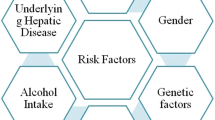Abstract
The DNA synthesis activities of hepatocytes in primary biliary cirrhosis (PBC) and other chronic liver diseases and control subjects were examined by staining proliferating cell nuclear antigen (PCNA) with anti-PCNA monoclonal antibody. The number of PCNA-positive cells (PCNA value) was significantly higher in PBC (375±281 parts per thousand; ppt) than in other chronic liver diseases, i.e., chronic hepatitis (95±83 ppt), liver cirrhosis (72±71 ppt), and alcoholic liver disease (73±56 ppt), and in control subjects (11±14 ppt). The PCNA value of PBC in stages I-III of Scheuer's classification was remarkably high, while in stage IV it was low. Even in identical, Scheuer's stages, the PCNA value of PBC was higher in patients who were not given ursodeoxycholic acid (UDCA) than in those who received UDCA. In identical patients, the PCNA value was lowered significantly after UDCA treatment. It was concluded that the DNA synthesis activity of PBC in stages I-III was accelerated and that UDCA can alleviate the abnormality in DNA synthesis activity.
Similar content being viewed by others
References
Long RG, Scheuer PJ, Sherlock S. Presentation and course of asymptomatic primary biliary cirrhosis. Gastroenterology 1977;72:1204–1207.
Ahrens EH Jr, Pater MA, Kunkel HG, et al. Primary biliary cirrhosis. Medicine 1950;29:299–364.
Hoffbauer FW. Primary biliary cirrhosis. Observation on the natural course of the disease in 25 women. Am J Dig Dis 1960;5:348–383.
Sherlock S. Primary libiary cirrhosis (chronic intrahepatic obstructive jaundice). Gastroenterology 1959;37:574–586.
Tarao K, Shimizu A, Ohkawa S, et al. Increased uptake of bromodeoxyuridine by hepatocytes from early stage of primary biliary cirrhosis. Gastroenterology 1991;100:725–730.
Miyachi K, Fritzler MJ, Tan EM. Autoantibody to a nuclear antigen in proliferating cells. J Immunol 1978;121:2228–2234.
Miyachi K, Tan EM. Characteristic of antibodies to proliferating cell nuclear antigens in SLE. In: Fukase M (eds) Systemic lupus erythematosus. Tokyo: University of Tokyo Press, 1980;247–260.
Bravo R, Frank R, Blundell PA, et al. Cyclin/PCNA is the auxiliary protein of DNA polymerase-delta. Nature 1987; 326:515–517.
Fairman MP. DNA polymeraseδ/PCNA: Actions and interactions. J Cell Sci 1990;95:1–4.
Takasaki Y, Fishwild D, Tan EM. Characterization of proliferating cell nuclear antigen recognized by autoantibodies in lupus sera. J Exp Med 1984;159:981–992.
Baserga R. Growth regulation of the PCNA gene. J Cell Sci 1991;98:433–436.
Tanaka K. Immunohistological staining of proliferating cell nuclei using monoclonal anti-PCNA antibody: Application to paraffin embedded tissue sections. Pathol Clin Med 1991; 9:791–798 (in Japanese).
Garcia RL, Coltrera MD, Gown AM, et al. Analysis of proliferative grade using anti-PCNA/cyclin monoclonal antibodies in fixed, embedded tissue. Am J Pathol 1989;4:733–739.
Tanaka K, Iwamoto T, Takahashi M. An immunohistological investigation of proliferating cells in tumorous lesions of the squamous epithelium using anti-PCNA antibody. Jpn J Cancer 1991:37:1487–1491 (in Japanese).
Sasaki H. Diagnostic criteria for primary biliary cirrhosis. 1981 Report of Joint Research Group for Intractable Hepatitis (Japanese Ministry of Public Health and Welfare) 1981;152 (in Japanese).
Nakamura Y, Hoso M, Mizuno Y, et al. Pathological study of primary biliary cirrhosis of early histological stages presenting cholestatic jaundice. Liver 1988;8:319–324.
Scheuer PJ. Liver biopsy interpretation. 3rd ed. London: Bailliere-Tindall, 1990.
Gratzner HG. Monoclonal antibody to 5-brome- and 5- iododeoxyuridine: A new reagent for detection of DNA replication. Science 1982;218:474–476.
Shimizu A, Tarao K, Takemiya S, et al. S-phase cells in diseased human liver determinend by an in vitro BrdU-anti-BrdU method. Hepatology 1988;8:535–1539.
Coltrera MD, Gown AM. PCNA/cyclin expression and BrdU uptake define different subpopulations in different cell lines. J Histochem Cytochem 1991;39;23–30.
Nakamura H, Morita T, Masaki S, et al. Intercellular localization and metabolism of DNA polymerase α in human cells visualized with monoclonal antibody. Exp Cell Res 1984; 151:123–133.
Mitani S, Tango T, Sonobe Y, et al. Expression of three cell proliferation-associated antigens, DNA polymerase α, Ki-67 antigen, and transferrin receptor in nodal and cutaneous T-cell lymphoma. Int J Hematol 1991;54:385–393.
Seki S, Sakaguchi H, Kawakita N, et al. Detection of proliferating liver cells in various diseases by a monoclonal antibody against polymerase-α: with special reference to the relationship between hepatocytes and sinusoidal cells. Hepatology 1991; 14:781–788.
Burger CP, Shibata T, Kleihues P. The use of the monoclonal antibody Ki-67 in the identification of proliferating cells. Am J Surg Pathol 1986;10:611–617.
Bruno S, Crissman HA, Bauer KD, et al. Changes in cell nuclei during S phase: Progressive chromatin condensation and altered expression of the proliferation-associated nuclear proteins Ki-67, cycline (PCNA), p105, and p34. Exp Cell Res 1991; 106:99–106.
Mitchison HC, Bassendine MF, Hendrick A, et al. Positive antimitochondrial antibody but normal alkaline phosphatase: Is this primary biliary cirrhosis? Hepatoiogy 1986;6:1279–1284.
Minoru S, Ueno Y, Yamamuro W, et al. Laparoscopic findings of asymptomatic primary biliary cirrhosis: Particular investigation in early PBC. Dig Endosc 1991:3:230–234.
Minoru S, Ueno Y, Yamamuro W, et al. Clinical and clinicopathological studies of early primary biliary cirrhosis. Acta Hepatol Jpn 1990;31:1400–1405 (in Japanese).
Poupon R, Chretien Y, Poupon RE, et al. Is ursodeoxycholic acid an effective treatment of primary biliary cirrhosis? Lancet 1987;I:834–835.
Calmus Y, Poupon R. Ursodeoxycholic acid (UDCA) in the treatment of chronic cholestatic diseases. Biochimie 1991; 73:1335–1338.
Author information
Authors and Affiliations
Rights and permissions
About this article
Cite this article
Shibata, M., Watanabe, M., Ueno, Y. et al. Clinicopathological study of proliferating cell nuclear antigen (PCNA) of hepatocytes in primary biliary cirrhosis. J Gastroenterol 29, 56–60 (1994). https://doi.org/10.1007/BF01229074
Received:
Accepted:
Issue Date:
DOI: https://doi.org/10.1007/BF01229074




